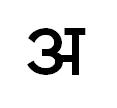Nga (Indic)
| Nga | |||||
|---|---|---|---|---|---|
| Devanagari | Bengali | Gurmukhi | Gujarati | Oriya | |
| ਙ | ઙ | ||||
| Tamil | Telugu | Kannada | Malayalam | Sinhala | |
| ங | ఙ | ಙ | ങ | ඞ | |
| Thai | Lao | Tibetan | Burmese | Khmer | |
| ง | ງ | ང | င | ង | |
| Baybayin | Hanunoo | Buhid | Tagbanwa | Lontara | |
| ᜅ | ᜥ | ᝅ | ᝥ | ᨂ | |
| Balinese | Sundanese | Limbu | Tai Le | New Tai Lue | |
| ᬗ | ᮍ | ᤅ | ᥒ | ᦇ | |
| Lepcha | Saurashtra | Rejang | Javanese | Cham | |
| ᰅ | ꢖ | ꤲ | ꦔ | ꨋ | |
| Tai Tham | Tai Viet | Kayah Li | Phags-pa | Siddhaṃ | |
| ᨦ | ꪈꪉ | ꤍ | ꡃ | ||
| Mahajani | Khojki | Khudabadi | Syloti | Meitei | |
| - | 𑈍 | 𑊿 | - | ꯡ | |
| Modi | Tirhuta | Kaithi | Sora | Grantha | |
| 𑘒 | 𑒓 | 𑂑 | 𑃗 | 𑌙 | |
| Chakma | Sharada | Takri | Kharoshthi | Brahmi | |
| 𑄋 | 𑆕 | 𑚎 | - | ||
| Phonemic representation: | /ŋ/ | ||||
| IAST transliteration: | nga | ||||
| ISCII code point: | B7 (183) | ||||
Nga is the fifth consonant of Indic abugidas. In modern Indic scripts, nga is derived from the Brahmi letter ![]() after having gone through the Gupta letter
after having gone through the Gupta letter ![]() .
.
Āryabhaṭa numeration
Aryabhata used Devanagari letters for numbers, very similar to the Greek numerals, even after the invention of Indian numerals. The values of the different forms of ङ are:[1]
- ङ [ŋə] = 5 (५)
- ङि [ŋɪ] = 500 (५००)
- ङु [ŋʊ] = 50,000 (५० ०००)
- ङृ [ŋri] = 5,000,000 (५० ०० ०००)
- ङॢ [ŋlə] = 5×108 (५०८)
- ङे [ŋe] = 5×1010 (५०१०)
- ङै [ŋɛː] = 5×1012 (५०१२)
- ङो [ŋoː] = 5×1014 (५०१४)
- ङौ [ŋɔː] = 5×1016 (५०१६)
Devanagari script
| Devanāgarī |
|---|
 |
|
Diacritics, punctuation, symbols |
Nga (ङ) is the fifth consonant of the Devanagari abugida. In all languages, ङ is pronounced as [ŋə] or [ŋ] when appropriate. Letters that derive from it are the Gujarati letter ઙ and the Modi letter 𑘒.
Bengali script
ঙ is used as a basic consonant character in all of the major Bengali script orthographies, including Bengali and Assamese.
Gujarati script
Nga (ઙ) is the fifth consonant of the Gujarati script. It is derived from 16th century Devanagari letter nga (ङ) with the top bar (shiro rekha) removed.
Gurmukhi script
Ngangaa [ŋɑŋːɑ̃] (ਙ) is the tenth letter of the Gurmukhi alphabet. Its name is [ŋɑŋːɑ̃] and is pronounced as /ŋ/ when used in words. It is derived from the Laṇḍā letter nga, and ultimately from the Brahmi nga. Gurmukhi ngangaa does not have a special pairin or addha (reduced) form for making conjuncts, and in modern Punjabi texts do not take a half form or halant to indicate the bare consonant /ŋ/, although Gurmukhi Sanskrit texts may use an explicit halant. Ngangaa rarely used. It cannot begin a syllable or be placed between two consonants, and occur most often as an allophone of /n/ before specific consonant phonemes.
Thai script
Ngo ngu (ง) is the seventh letter of the Thai script. It falls under the low class of Thai consonants. In IPA, ngo ngu is pronounced as [ŋ] at the beginning of a syllable and at the end of a syllable. Unlike many Indic scripts, Thai consonants do not form conjunct ligatures, and use the pinthu—an explicit virama with a dot shape—to indicate bare consonants. In the acrophony of the Thai script, ngu (งู) means ‘snake’. Ngo ngu corresponds to the Sanskrit character ‘ङ’.
Javanese script
References
- Kurt Elfering: Die Mathematik des Aryabhata I. Text, Übersetzung aus dem Sanskrit und Kommentar. Wilhelm Fink Verlag, München, 1975, ISBN 3-7705-1326-6
- Georges Ifrah: The Universal History of Numbers. From Prehistory to the Invention of the Computer. John Wiley & Sons, New York, 2000, ISBN 0-471-39340-1.
- B. L. van der Waerden: Erwachende Wissenschaft. Ägyptische, babylonische und griechische Mathematik. Birkhäuser-Verlag, Basel Stuttgart, 1966, ISBN 3-7643-0399-9
- Fleet, J. F. (January 1911). "Aryabhata's System of Expressing Numbers". Journal of the Royal Asiatic Society of Great Britain and Ireland: 109–126. ISSN 0035-869X. JSTOR 25189823.
- Fleet, J. F. (1911). "Aryabhata's System of Expressing Numbers". The Journal of the Royal Asiatic Society of Great Britain and Ireland. Royal Asiatic Society of Great Britain and Ireland. 43: 109–126. doi:10.1017/S0035869X00040995. JSTOR 25189823.